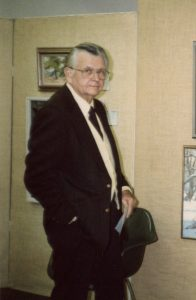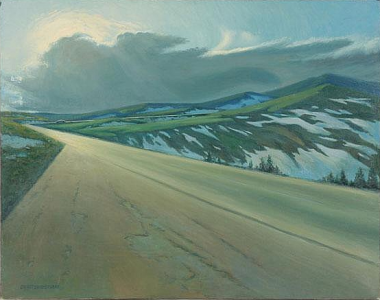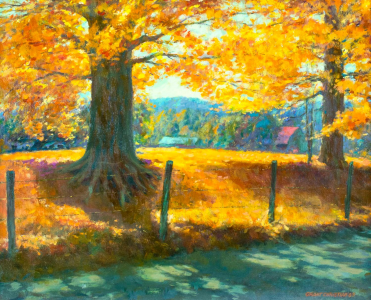
Biography
Grant Wright Christian was born in Edinburgh, IN in 1911. From 1929-1933 he studied at the John Herron Art Institute in Indianapolis. He spent the next year at the Pennsylvania Academy of the Fine Arts (PAFA) in Philadelphia, returning to the Herron Institute for a fifth year in 1934. While at PAFA he studied with the Delaware-based illustrator Frank Schoonover, who had a summer studio in Bushkill, PA.
Back at Herron, Christian was influenced by Donald Mattison and Henrik Martin Mayer. He became interested in mural decoration, and Mattison and Mayer encouraged him to submit designs in federal competitions, including the Louisville Marine Hospital and the Lafayette, IN Post Office. He was not immediately successful; in fact Mayer himself won both of these competitions; but Christian's efforts bore fruit a shortly thereafter.
In 1936 Christian received a commission to paint two murals in the Indianapolis Courthouse: "Mail, Transportation and Delivery" and "Early Present Day Indianapolis Life." Also in 1936 Christian's entry for the Hoosier Salon, "The Edge of Town," received the Thomas Meek Butler Prize for outstanding landscape. Christian taught oil painting, watercolor, and composition at Indiana University in the 1936-1937 academic year and received a commission for the Nappanee, IN Post Office with his mural "Waiting for the Mail."
In 1937 Christian began what was to be a long-term relationship with the advertising agency Keeling & Company. He married Clara M. Schneider, another Herron graduate, in 1942. They had two children: Anthony Booth (b.1949) and Susan Ann (b.1952). During World War II Christian served with the Army's Filmstrip Preparation Unit. He received a prize from the Seth Thomas Clock Company for his design of the "Clock of Tomorrow" in 1944.
By 1951 Christian had become a Vice President and a member of the Board of Directors of Keeling & Company. Keeling merged with Bozell & Jacobs, Inc. in 1959, at which time Christian became Vice President and Art Director for the merged entity. This position lasted until 1968, when their offices closed. At this time Christian set up his independent Christian Studio to pursue free-lance assignments.
Christian won a design contest designing the entryway to the Indiana State Fairgrounds in 1969. Although he got his cash prize, the gate that he designed was never built. In 1972 he joined the Mathewson Group, another advertising agency, where he worked until his retirement in 1981. Here, again, he rose to become an Art Director and a Vice President.
Throughout his career in advertising Christian continued to paint. His entries to the Hoosier Salon exhibitions in 1987-1989 came away with awards. In earlier years his art had been shown at the Indiana State Fair, the Swope Gallery in Terre Haute, IN, the Grand Central Gallery in New York, the Cororan Gallery in Washington D.C., and the Whitney Museum of American Art in New York, among other places. He died in Franklin, IN in 1989.



Critical Analysis
Grant Christian painted murals in Indianapolis, IN and Nappanee, IN. His murals for the Indianapolis Courthouse were painted when he was 24 years old, just out of the Herron School of Art. Given his youth, these compositions are remarkable in their complexity and striking in the brilliance of their execution. His mural for the Nappanee, IN Post Office, "Waiting for the Mail," has become an iconic expression of patience and longing, often reproduced with works in this context, and eerily anticipating the sentiments that would arise so often during World War II. Interestingly, Christian's initial submission to the Treasury Relief Art Program (TRAP) featured a long white fence across the width of the painting. TRAP official Edward Rowan criticized this feature as being a bit monotonous and suggested the addition of a dog somewhere along the fence. Viewers likely respond to the patiently waiting dog as strongly as they do to the patiently waiting woman on the right, so this is a case where a TRAP official definitely improved upon the artist's original concept.
Given Christian's long detour into the advertising world around the time of the Nappanee mural, this was the last mural he created. This feels like something of a loss to the world of art, since Christian was clearly one of the most competent and imaginative of the Depression Era muralists. Examples of Christian's easel paintings are mostly landscapes - skillfully executed, placid scenes that lack something of the vitality of his more ambitious murals.
Murals
- Nappanee, Indiana - Post Office: Waiting for the Mail
References
- Biography of Grant Wright Christian (Artprice).
- Clara M. Schneider Christian (Find a Grave).
- Grant Wright Christian (Find a Grave).
- Grant Wright Christian (Wikipedia).
- Grant Wright Christian (Encyclopedia of Indiana).
- Grant Wright Christian (Fine Estate Art).
- Grant Wright Christian (Artprice).